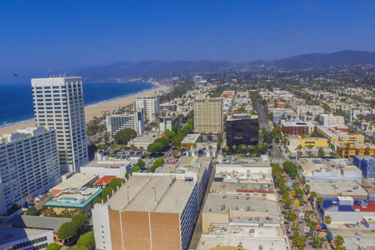How Santa Monica Became A Sustainable Water Leader
By Katie Peach

Lessons in urban water management through water conservation, capture, and reuse.
California’s ongoing water challenges have pushed cities and municipalities to seek innovative solutions for sustainable water supplies. The city of Santa Monica’s pioneering sustainable water master plan1 aims to secure water resources, reduce the city’s energy footprint, and provide long-term cost benefits for ratepayers. The plan’s three main elements include increasing water conservation efforts, creating sustainable alternative water supplies, and expanding local groundwater production.
One component of that plan, the Sustainable Water Infrastructure Project2 (SWIP), has emerged as a blueprint for other local governments to emulate, representing a significant shift in urban water management and reuse.
SWIP combines several components to maximize local water resources and reduce reliance on imported water. The project’s centerpiece is the advanced water treatment facility (AWTF), an underground facility processing 1 million gallons daily, California’s first permitted groundwater augmentation project using a membrane bioreactor.
Complementing AWTF is the Santa Monica Urban Runoff Recycling Facility (SMURRF). It produces up to 500 acre-feet of Title 22 diluent water per year for groundwater replenishment, marking another first for California as the state’s first stormwater direct injection project.
The third key component is a new 1.5-million-gallon stormwater harvesting tank at the city’s Civic Center to complement the existing 1.6-million-gallon Clean Beaches Initiative Tank, which helps capture stormwater and manage urban runoff to contribute significantly to the city’s water recycling capacity.
By integrating each of these components, Santa Monica has created a system that captures and treats stormwater, urban runoff, and wastewater, allowing the city to harvest rainwater and urban runoff that would otherwise go to waste and purify it to surpass drinking water standards.
The city of Santa Monica caters to the daily water needs of over 93,000 residents and 2,700 commercial customers, delivering 10 million gallons daily of high-quality drinking water; SWIP aims to reduce Santa Monica’s reliance on imported water by 10%. SWIP also showcases Santa Monica’s commitment to cuttingedge environmental practices and ensures climate resilience in the face of drought by reducing dependence on imported water and maximizing the use of local resources.
How The Advanced Water Treatment Facility (AWTF) Was Built
AWTF’s groundbreaking solution incorporates a multi-barrier approach, pushing the boundaries of water treatment technology. The treatment steps include a LEAPmbr system3, cartridge filtration, reverse osmosis (RO), ultraviolet disinfection, and free chlorine disinfection.
Veolia Water Tech partnered with the city to provide the membrane bioreactor (MBR) system as the core of the facility. The system produces high-quality effluent to send to the downstream advanced treatment technologies and marks a significant milestone as the first MBR granted log removal values (LRVs) for virus, Cryptosporidium, and Giardia removal in California.
Following the MBR, water passes through cartridge filters, another first in California to be granted LRVs. The subsequent RO system operates highly efficiently and further purifies the water by removing dissolved solids and contaminants.
Post-RO, an advanced oxidation process using ultraviolet light and free chlorine (UV/Cl2) destroys remaining pathogens and breaks down trace organic compounds. A final free chlorine disinfection step provides residual protection.
What sets AWTF apart is its integration of these technologies into a cohesive system with multiple critical control points that monitor parameters like turbidity, conductivity, UV transmittance, and free chlorine residual, ensuring consistent water quality throughout treatment.
These innovations collectively enable SWIP to produce water that exceeds drinking water standards. By housing the entire AWTF underground, Santa Monica minimized the facility’s urban footprint and provided additional protection for the treatment processes. Additionally, Veolia has completed a greenhouse gas (GHG) emission analysis for the AWTF that demonstrates that the city is able to reach its goals of water independence while also achieving a similar GHG emission or less when compared to the emissions from importing water.
Keys To Success
From the outset, the city adopted a design-build-delivery model to streamline the project’s execution and ensure accountability. This approach gave the contractor and engineer a single point of responsibility for performance, fostering a sense of shared purpose and aligning interests toward the project’s success.
The team quickly realized that in the world of advanced water treatment, analyzers aren’t just tools — they’re the eyes and ears of the entire operation. This revelation led to a deep appreciation for the nuances of water chemistry and the importance of selecting the right analytical methods for processes like UV-chlorine advanced oxidation.
When traditional methods of monitoring cartridge filtration proved inadequate, the city created new parameters like temperature-corrected specific flux and normalized differential pressure. They also discovered that operational flexibility could be a powerful tool in balancing cost and risk and developing a hybrid “threshold mode” for the UV-AOP system to find a sweet spot of oxidant dosing that maintains water quality and protection while optimizing operational costs.
As the project neared completion, the multiple barrier treatment system proved its worth with its array of critical control points. Extensive sampling revealed no maximum contaminant level exceedances in the product water.
Capturing Urban Runoff For Groundwater Injection
Leading the way for water recycling is nothing new for Santa Monica, where the SMURRF has been operating since 2000. Originally designed and operated to collect and treat stormwater runoff to provide non-potable water for irrigation and toilet flushing, the SMURRF system also uses ZeeWeed membranes to meet Title 22 recycling requirements. The facility has undergone recent upgrades as part of SWIP, including the addition of reverse osmosis to further purify the water, and it is the first facility in California to directly inject treated stormwater into the groundwater basin.
As other cities and water agencies look to chart their own paths toward sustainable water infrastructure, they should heed these lessons from Santa Monica’s journey. The experience planted the seeds of future innovations and successes in the quest for sustainable urban water management.
References:
- https://www.santamonica.gov/Media/Users/smgov_5Calfredo_2Egonzalez/Water_Rate_Files/
City_of_Santa_Monica_SWMP_122018.pdf - https://www.santamonica.gov/sustainable-water-infrastructure-project-swip
- https://www.watertechnologies.com/products/biological/zeeweed-membranebioreactor-wastewater
About The Author
 Katie Peach, technical sales engineer for Veolia's water technology activities in North America, has a B.Sc. in chemical engineering and is a licensed P. Eng in Ontario. She has over 10 years of experience in the water and wastewater industry, previously working in field service and as a process engineer. Katie is Veolia’s Leader for Advanced Reuse, working with industrial and municipal customers to create sustainable water sources through water recycling solutions. She is a 2021 graduate of the WEF Water Leadership Institute program and a member of the WEF Water Reuse Community.
Katie Peach, technical sales engineer for Veolia's water technology activities in North America, has a B.Sc. in chemical engineering and is a licensed P. Eng in Ontario. She has over 10 years of experience in the water and wastewater industry, previously working in field service and as a process engineer. Katie is Veolia’s Leader for Advanced Reuse, working with industrial and municipal customers to create sustainable water sources through water recycling solutions. She is a 2021 graduate of the WEF Water Leadership Institute program and a member of the WEF Water Reuse Community.
